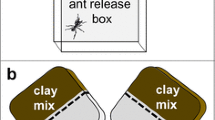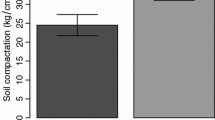Abstract
How animals sense, process, and use magnetic information remains elusive. In insects, magnetic particles are candidates for a magnetic sensor. Recent studies suggest that the ant Pachycondyla marginata incorporates iron-containing particles from soil. We used leaf-cutter ants Atta colombica to test whether soil contact is necessary for developing a functional magnetic compass. A. colombica is the only invertebrate known to calculate a path-integrated home vector using a magnetic compass. Here, we show that A. colombica requires contact with soil to incorporate magnetic particles that can be used as a magnetic compass; yet, we also show that ants can biosynthesize magnetic particles. Workers from a soil-free colony ignored a 90° shift in the horizontal component of the geomagnetic field, yet oriented homeward despite the occlusion of any geocentric cues. In contrast, workers from a soil-exposed colony oriented to an intermediate direction between their true and subjective home in the shifted field. Homeward orientations under shifted fields suggest that ants calculated a path-integrated vector using proprioceptive information. Strikingly, ants from the soil-free colony also had magnetic particles; yet, as observed by ferromagnetic resonance, these particles differed from those in soil-exposed ants and were not associated with a magnetic compass sensitive to this experimental manipulation.



Similar content being viewed by others
References
Abraçado LG, Esquivel DMS, Wajnberg E (2012) ZFC/FC of oriented magnetic material in Solenopsis interrupta head with antennae: characterization by FMR and SQUID. J Biol Phys 38:607–621
Alves O, Wajnberg E, de Oliveira JF, Esquivel DMS (2004) Magnetic material arrangement in oriented termites: a magnetic resonance study. J Magn Res 168:246–251
Banks AN, Srygley RB (2003) Orientation by magnetic field in leaf-cutter ants, Atta colombica (Hymenoptera: Formicidae). Ethol 109:835–846
Bharde A, Rautaray D, Bansal V, Ahmad A, Sarkar I, Yusuf SM, Sanyal M, Sastry M (2006) Extracellular biosynthesis of magnetite using fungi. Small 2:135–141
Briat JF, Duc C, Ravet K, Gaymard F (2010) Ferritins and iron storage in plants. Biochem Biophys Acta 1800:806–814
Cadiou H, McNaughton PA (2010) Avian magnetite-based magnetoreception: a physiologist’s perspective. J Roy Soc Interface 7:S193–S205
DeJong D (1982) Orientations of comb-building by honey bees. J Comp Physiol 147:495–501
Etienne AS, Teroni E, Hurni C, Portenier V (1990) The effect of a single light cue on homing behaviour of the golden hamster. Anim Behav 39:17–41
Etienne AS, Maurer R, Seguinot V (1996) Path integration in mammals and its interaction with visual landmarks. J Exp Biol 199:201–209
Gould JL (2010) Magnetoreception. Curr Biol 20:R431–R435
Gould JL, Kirschvink JL, Deffeyes KS (1978) Bees have magnetic remanence. Science 201:1026–1028
Herz H, Beyschlag W, Hölldobler B (2007) Herbivory rate of leaf-cutting ants in a tropical moist forest in Panama at the population and ecosystem scales. Biotropica 39:482–488
Herz H, Hölldobler B, Roces F (2008) Delayed rejection in a leaf-cutting ant after foraging on plants unsuitable for the symbiotic fungus. Behav Ecol 19:575–582
Jeong J, Guerinot ML (2009) Homing in on iron homeostasis in plants. Trends Plant Sci 14:280–285
Johnsen S, Lohmann KJ (2008) Magnetoreception in animals. Phys Today 61:29–35
Kirschvink JL, Gould JL (1981) Biogenic magnetite as a basis for magnetic field detection in animals. Biosystems 13:181–201
Kirschvink JL, Winklhofer M, Walker MM (2010) Biophysics of magnetic orientation: strengthening the interface between theory and experimental design. J Roy Soc Interface 7:S179–S191
Kisliuk M, Ishay J (1977) Influence of an additional magnetic field on hornet nest architecture. Cell Mol Life Sci 33:885–887
Oliveira JF, Wajnberg E, Esquivel DMS, Weinkauf S, Winklhofer M, Hanzlik M (2010) Ant antennae: are they sites for magnetoreception? J Roy Soc Interface 7:143–152
Riveros AJ, Srygley RB (2008) Do leaf-cutter ants Atta colombica orient their path-integrated, home vector with a magnetic compass? Anim Behav 75:1273–1281
Rubens SM (1945) Cube-surface coil for producing a uniform magnetic field. Rev Sci Instr 16:243–246
Seipke RF, Kaltenpoth M, Hutchings MI (2011) Streptomyces as symbionts: an emerging and widespread theme? FEMS Microbiol Rev 4:862–876
Vogt JT, Wallet B, Freeland TB Jr (2008) Imported fire ant (Hymenoptera:Formicidae) mound shape characteristics along a north–south gradient. Environ Entomol 37:198–205
Vowles DM (1954) The orientation of ants. II. Orientation to light, gravity and polarized light. J Exp Biol 31:356–375
Wajnberg E, Acosta-Avalos D, Alves OC, de Oliveira JF, Srygley RB, Esquivel DMS (2010) Magnetoreception in eusocial insects: an update. J Roy Soc Interface 7:S207–S225
Walker MM, Bitterman ME (1985) Conditioned responding to magnetic fields by honeybees. JComp Physiol A 157:67–71
Wehner R, Michel B, Antonsen P (1996) Visual navigation in insects: coupling of egocentric and geocentric information. J Exp Biol 199:129–140
Wetterer J, Shafir S, Morrison L, Lips K, Gilbert G, Cipollini M, Blaney C (1992) On- and off-trail orientation in the leaf-cutting ant, Atta cephalotes L. (Hymenoptera Formicidae). J Kansas Entomol Soc 65:96–98
Wiltschko R, Wiltschko W (1995) Magnetic Orientation in Animals. Springer, Berlin
Winklhofer M (2010) Magnetoreception. J Roy Soc Interface 7:S131–S134
Winklhofer M, Kirschvink JL (2010) A quantitative assessment of torque-transducer models for magnetoreception. J Roy Soc Interface 7:273–289
Wirth R, Herz H, Ryel RJ, Beyschlag W, Hölldobler B (2003) Herbivory of leaf-cutting ants: a case study on Atta colombica in the tropical rainforest of Panama. Springer, Berlin
Wittlinger M, Wehner R, Wolf H (2006) The ant odometer: stepping on stilts and stumps. Science 312:1965–1967
Wohlgemuth S, Ronacher B, Wehner R (2001) Ant odometry in the third dimension. Nature 411:795–798
Wolf H (2010) Odometry and insect navigation. J Exp Biol 214:1629–1641
Acknowledgments
We thank Hubert Herz for allowing the use of the laboratory-maintained, soil-free colony. We thank L. Senior (USDA-ARS) for measuring the ant orientations from the video tapes. We thank J. Gaskin, S. Adamo, and two anonymous reviewers for their comments on an earlier version of this manuscript. The Autoridad Nacional del Ambiente (ANAM) granted permission to conduct the research in Panama and export ants to Brazil for physical analysis. This project was supported in part by Centro Brasileiro de Pesquisas Fisicas (CBPF) of the Ministério da Ciência, Tecnologia e Inovação (MCTI). AJR received support from National Science Foundation grant IOB-0519483 (to Wulfila Gronenberg) and from the United States Department of Agriculture (USDA).
Author information
Authors and Affiliations
Corresponding author
Additional information
Communicated by W. Wiltschko
Electronic supplementary material
Below is the link to the electronic supplementary material.
Fig. S1
Representative spectra of soil exposed ants (full lines) and of the local soil at three orientations positioned 45º one from each other around the vertical (dotted lines). The acquisition parameters are the same for all ants (see Methods); numbers close to the spectra are arbitrary multiplying factors. Incomplete low field (LF) region (g > 4.3, dotted vertical line) is indicated by an arrow. The circulated region in the soil spectra indicates the low intensity features that are associated with the high field (HF) components of the soil exposed ant spectra. The g = 2.7 component is only observed in soil spectra. The vertical axis is in arbitrary units. (JPEG 186 kb)
Fig. S2
Spectra of all soil free ants. The acquisition parameters are the same for all ants (see Methods). Numbers close to the spectra are arbitrary multiplying factors. Incomplete low field (LF) region (g > 4.3, dotted vertical line) is indicated by an arrow. (a) The high field (HF) component is clearly observed in the region from 2.3 to 2.6 (vertical dashed lines). (b) The LF component is easily observed and HF component falls in the geff region from 2.1 to 3.7 (vertical dashed lines). The vertical scale, in arbitrary units, is the same for (a) and (b). (JPEG 63 kb)
Rights and permissions
About this article
Cite this article
Riveros, A.J., Esquivel, D.M.S., Wajnberg, E. et al. Do leaf-cutter ants Atta colombica obtain their magnetic sensors from soil?. Behav Ecol Sociobiol 68, 55–62 (2014). https://doi.org/10.1007/s00265-013-1621-7
Received:
Revised:
Accepted:
Published:
Issue Date:
DOI: https://doi.org/10.1007/s00265-013-1621-7




